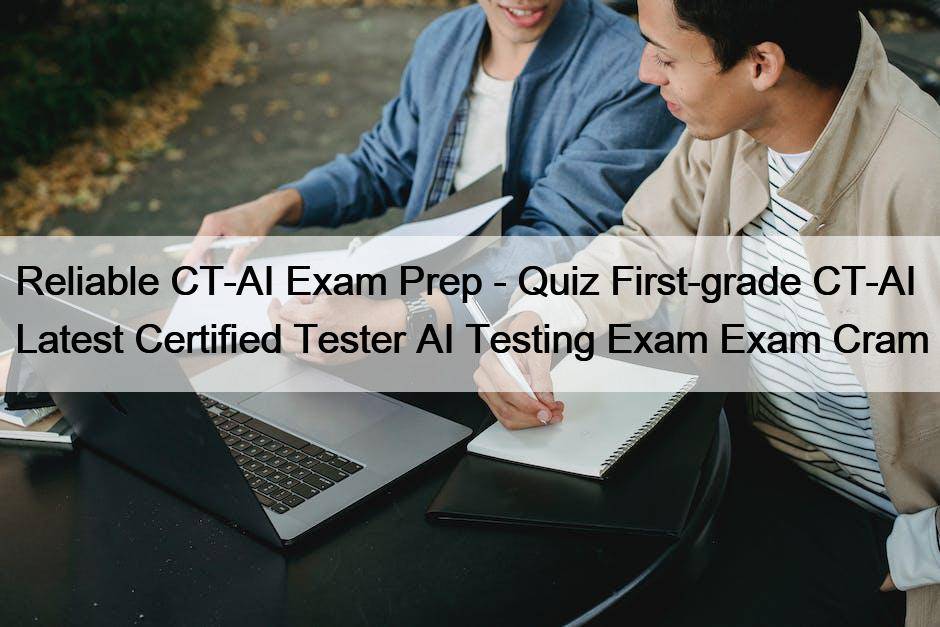Most Popular
 Reliable CT-AI Exam Prep - Quiz First-grade CT-AI Latest Certified Tester AI Testing Exam Exam Cram
Reliable CT-AI Exam Prep - Quiz First-grade CT-AI Latest Certified Tester AI Testing Exam Exam Cram
BONUS!!! Download part of ITExamDownload CT-AI dumps for free: https://drive.google.com/open?id=1WG3SkbrvNAi3414UavaqM31RNl1v70jKThere ...
 New PMHC Test Forum | PDF PMHC VCE
New PMHC Test Forum | PDF PMHC VCE
In the era of information, everything around us is changing ...
 Free PDF Quiz 2025 Microsoft Trustable SC-300: Microsoft Identity and Access Administrator Exam Passing Score
Free PDF Quiz 2025 Microsoft Trustable SC-300: Microsoft Identity and Access Administrator Exam Passing Score
DOWNLOAD the newest PassSureExam SC-300 PDF dumps from Cloud Storage ...



Reliable CT-AI Exam Prep - Quiz First-grade CT-AI Latest Certified Tester AI Testing Exam Exam Cram

BONUS!!! Download part of ITExamDownload CT-AI dumps for free: https://drive.google.com/open?id=1WG3SkbrvNAi3414UavaqM31RNl1v70jK
There are three versions of our CT-AI study questions on our website: the PDF, Software and APP online. And our online test engine and the windows software of the CT-AI guide materials are designed more carefully. During our researching and developing, we always obey the principles of conciseness and exquisiteness. All pages of the CT-AI Exam simulation are simple and beautiful. As long as you click on them, you can find the information easily and fast.
ISTQB CT-AI Exam Syllabus Topics:
| Topic | Details |
|---|---|
| Topic 1 |
|
| Topic 2 |
|
| Topic 3 |
|
| Topic 4 |
|
| Topic 5 |
|
| Topic 6 |
|
>> Reliable CT-AI Exam Prep <<
Latest CT-AI Exam Cram, Free CT-AI Exam
Our CT-AI learning prep boosts the self-learning, self-evaluation, statistics report, timing and test stimulation functions and each function plays their own roles to help the clients learn comprehensively. The self-learning and self-evaluation functions of our CT-AI guide materials help the clients check the results of their learning of the CT-AI Study Materials. The timing function of our CT-AI training quiz helps the learners to adjust their speed to answer the questions and keep alert and our study materials have set the timer.
ISTQB Certified Tester AI Testing Exam Sample Questions (Q82-Q87):
NEW QUESTION # 82
A wildlife conservation group would like to use a neural network to classify images of different animals. The algorithm is going to be used on a social media platform to automatically pick out pictures of the chosen animal of the month. This month's animal is set to be a wolf. The test teamhas already observed that the algorithm could classify a picture of a dog as being a wolf because of the similar characteristics between dogs and wolves. To handle such instances, the team is planning to train the model with additional images of wolves and dogs so that the model is able to better differentiate between the two.
What test method should you use to verify that the model has improved after the additional training?
- A. Adversarial testing to verify that no incorrect images have been used in the training.
- B. Metamorphic testing because the application domain is not clearly understood at this point.
- C. Back-to-back testing using the version of the model before training and the new version of the model after being trained with additional images.
- D. Pairwise testing using combinatorics to look at a long list of photo parameters.
Answer: C
Explanation:
Back-to-back testing isused to compare two different versions of an ML model, which is precisely what is needed in this scenario.
* The model initiallymisclassified dogs as wolvesdue to feature similarities.
* Thetest team retrains the modelwith additional images of dogs and wolves.
* The best way to verify whether this additional trainingimproved classification accuracyis to compare theoriginal model's output with the newly trained model's output using the same test dataset.
* A (Metamorphic Testing):Metamorphic testing is useful forgenerating new test casesbased on existing ones but does not directly compare different model versions.
* B (Adversarial Testing):Adversarial testing is used to check how robust a model is againstmaliciously perturbed inputs, not to verify training effectiveness.
* C (Pairwise Testing):Pairwise testing is a combinatorial technique for reducing the number of test casesby focusing on key variable interactions, not for validating model improvements.
* ISTQB CT-AI Syllabus (Section 9.3: Back-to-Back Testing)
* "Back-to-back testing is used when an updated ML model needs to be compared against a previous version to confirm that it performs better or as expected".
* "The results of the newly trained model are compared with those of the prior version to ensure that changes did not negatively impact performance".
Why Other Options Are Incorrect:Supporting References from ISTQB Certified Tester AI Testing Study Guide:Conclusion:To verify that the model's performance improved after retraining,back-to-back testing is the most appropriate methodas it compares both model versions. Hence, thecorrect answer is D.
NEW QUESTION # 83
Which ONE of the following statements correctly describes the importance of flexibility for Al systems?
SELECT ONE OPTION
- A. Al systems require changing of operational environments; therefore, flexibility is required.
- B. Al systems are inherently flexible.
- C. Self-learning systems are expected to deal with new situations without explicitly having to program for it.
- D. Flexible Al systems allow for easier modification of the system as a whole.
Answer: D
Explanation:
Flexibility in AI systems is crucial for various reasons, particularly because it allows for easier modification and adaptation of the system as a whole.
AI systems are inherently flexible (A): This statement is not correct. While some AI systems may be designed to be flexible, they are not inherently flexible by nature. Flexibility depends on the system's design and implementation.
AI systems require changing operational environments; therefore, flexibility is required (B): While it's true that AI systems may need to operate in changing environments, this statement does not directly address the importance of flexibility for the modification of the system.
Flexible AI systems allow for easier modification of the system as a whole (C): This statement correctly describes the importance of flexibility. Being able to modify AI systems easily is critical for their maintenance, adaptation to new requirements, and improvement.
Self-learning systems are expected to deal with new situations without explicitly having to program for it (D): This statement relates to the adaptability of self-learning systems rather than their overall flexibility for modification.
Hence, the correct answer is C. Flexible AI systems allow for easier modification of the system as a whole.
Reference:
ISTQB CT-AI Syllabus Section 2.1 on Flexibility and Adaptability discusses the importance of flexibility in AI systems and how it enables easier modification and adaptability to new situations.
Sample Exam Questions document, Question #30 highlights the importance of flexibility in AI systems.
NEW QUESTION # 84
Upon testing a model used to detect rotten tomatoes, the following data was observed by the test engineer, based on certain number of tomato images.
For this confusion matrix which combinations of values of accuracy, recall, and specificity respectively is CORRECT?
SELECT ONE OPTION
- A. 1,0.87,0.84
- B. 1,0.9, 0.8
- C. 0.87.0.9. 0.84
- D. 0.84.1,0.9
Answer: C
Explanation:
To calculate the accuracy, recall, and specificity from the confusion matrix provided, we use the following formulas:
Confusion Matrix:
Actually Rotten: 45 (True Positive), 8 (False Positive)
Actually Fresh: 5 (False Negative), 42 (True Negative)
Accuracy:
Accuracy is the proportion of true results (both true positives and true negatives) in the total population.
Formula: Accuracy=TP+TNTP+TN+FP+FNtext{Accuracy} = frac{TP + TN}{TP + TN + FP + FN}Accuracy=TP+TN+FP+FNTP+TN Calculation: Accuracy=45+4245+42+8+5=87100=0.87text{Accuracy} = frac{45 + 42}{45 + 42 + 8 + 5} = frac{87}{100} = 0.87Accuracy=45+42+8+545+42=10087=0.87 Recall (Sensitivity):
Recall is the proportion of true positive results in the total actual positives.
Formula: Recall=TPTP+FNtext{Recall} = frac{TP}{TP + FN}Recall=TP+FNTP Calculation: Recall=4545+5=4550=0.9text{Recall} = frac{45}{45 + 5} = frac{45}{50} = 0.9Recall=45+545=5045=0.9 Specificity:
Specificity is the proportion of true negative results in the total actual negatives.
Formula: Specificity=TNTN+FPtext{Specificity} = frac{TN}{TN + FP}Specificity=TN+FPTN Calculation: Specificity=4242+8=4250=0.84text{Specificity} = frac{42}{42 + 8} = frac{42}{50} = 0.84Specificity=42+842=5042=0.84 Therefore, the correct combinations of accuracy, recall, and specificity are 0.87, 0.9, and 0.84 respectively.
Reference:
ISTQB CT-AI Syllabus, Section 5.1, Confusion Matrix, provides detailed formulas and explanations for calculating various metrics including accuracy, recall, and specificity.
"ML Functional Performance Metrics" (ISTQB CT-AI Syllabus, Section 5).
NEW QUESTION # 85
Which of the following is one of the reasons for data mislabelling?
- A. Interoperability error
- B. Expert knowledge
- C. Lack of domain knowledge
- D. Small datasets
Answer: C
Explanation:
Data mislabeling occurs for several reasons, which can significantly impact the performance of machine learning (ML) models, especially in supervised learning. According to the ISTQB Certified Tester AI Testing (CT-AI) syllabus, mislabeling of data can be caused by the following factors:
* Random errors by annotators- Mistakes made due to accidental misclassification.
* Systemic errors- Errors introduced by incorrect labeling instructions or poor training of annotators.
* Deliberate errors- Errors introduced intentionally by malicious data annotators.
* Translation errors- Occur when correctly labeled data in one language is incorrectly translated into another language.
* Subjectivity in labeling- Some labeling tasks require subjective judgment, leading to inconsistencies between different annotators.
* Lack of domain knowledge- If annotators do not have sufficient expertise in the domain, they may label data incorrectly due to misunderstanding the context.
* Complex classification tasks- The more complex the task, the higher the probability of labeling mistakes.
Among the answer choices provided, "Lack of domain knowledge" (Option A) is the best answer because expertise is essential to accurately labeling data in complex domains such as medical, legal, or engineering fields.
Certified Tester AI Testing Study Guide References:
* ISTQB CT-AI Syllabus v1.0, Section 4.5.2 (Mislabeled Data in Datasets)
* ISTQB CT-AI Syllabus v1.0, Section 4.3 (Dataset Quality Issues)
NEW QUESTION # 86
Which ONE of the following statements is a CORRECT adversarial example in the context of machine learning systems that are working on image classifiers.
SELECT ONE OPTION
- A. These attacks can't be prevented by retraining the model with these examples augmented to the training data.
- B. These attack examples cause a model to predict the correct class with slightly less accuracy even though they look like the original image.
- C. These examples are model specific and are not likely to cause another model trained on same task to fail.
- D. Black box attacks based on adversarial examples create an exact duplicate model of the original.
Answer: C
Explanation:
A . Black box attacks based on adversarial examples create an exact duplicate model of the original.
Black box attacks do not create an exact duplicate model. Instead, they exploit the model by querying it and using the outputs to craft adversarial examples without knowledge of the internal workings.
B . These attack examples cause a model to predict the correct class with slightly less accuracy even though they look like the original image.
Adversarial examples typically cause the model to predict the incorrect class rather than just reducing accuracy. These examples are designed to be visually indistinguishable from the original image but lead to incorrect classifications.
C . These attacks can't be prevented by retraining the model with these examples augmented to the training data.
This statement is incorrect because retraining the model with adversarial examples included in the training data can help the model learn to resist such attacks, a technique known as adversarial training.
D . These examples are model specific and are not likely to cause another model trained on the same task to fail.
Adversarial examples are often model-specific, meaning that they exploit the specific weaknesses of a particular model. While some adversarial examples might transfer between models, many are tailored to the specific model they were generated for and may not affect other models trained on the same task.
Therefore, the correct answer is D because adversarial examples are typically model-specific and may not cause another model trained on the same task to fail.
NEW QUESTION # 87
......
The ITExamDownload is one of the leading platforms that have been offering valid, updated, and real Channel Partner Program CT-AI exam dumps for many years. The Channel Partner Program Certified Tester AI Testing Exam CT-AI Practice Test questions offered by the ITExamDownload are designed and verified by experienced Certified Tester AI Testing Exam CT-AI certification exam trainers.
Latest CT-AI Exam Cram: https://www.itexamdownload.com/CT-AI-valid-questions.html
- CT-AI Pass-Sure Materials: Certified Tester AI Testing Exam - CT-AI Actual Test - CT-AI Test Torrent 🍧 Search for ➡ CT-AI ️⬅️ and download exam materials for free through ✔ www.examsreviews.com ️✔️ 🧾CT-AI Dumps Vce
- Gauge Your Performance and Identify Weaknesses with Online ISTQB CT-AI Practice Test Engine 🤮 Download ⮆ CT-AI ⮄ for free by simply entering ✔ www.pdfvce.com ️✔️ website ⛰CT-AI Valid Exam Test
- CT-AI Valid Test Fee 🔤 Authorized CT-AI Pdf 🍾 CT-AI Sample Test Online 🧩 Open website ▶ www.free4dump.com ◀ and search for ➠ CT-AI 🠰 for free download 🎯Exam CT-AI PDF
- CT-AI Exam Torrent - CT-AI Exam Bootcamp - CT-AI Exam Cram 🗜 Copy URL ⇛ www.pdfvce.com ⇚ open and search for ⇛ CT-AI ⇚ to download for free 🎎CT-AI 100% Correct Answers
- CT-AI Exam Torrent - CT-AI Exam Bootcamp - CT-AI Exam Cram 💼 Simply search for ➥ CT-AI 🡄 for free download on [ www.vceengine.com ] 🏙Exam CT-AI PDF
- Top Reliable CT-AI Exam Prep Free PDF | Professional Latest CT-AI Exam Cram: Certified Tester AI Testing Exam 🩸 Easily obtain ( CT-AI ) for free download through [ www.pdfvce.com ] 🦰CT-AI Latest Exam Questions
- CT-AI Exam Torrent - CT-AI Exam Bootcamp - CT-AI Exam Cram 🔏 Go to website ☀ www.passcollection.com ️☀️ open and search for ▛ CT-AI ▟ to download for free 📟CT-AI Valid Test Fee
- CT-AI Exam Torrent - CT-AI Exam Bootcamp - CT-AI Exam Cram 🌌 Search on ⇛ www.pdfvce.com ⇚ for ➥ CT-AI 🡄 to obtain exam materials for free download 👆Authorized CT-AI Pdf
- 100% Pass Quiz Updated CT-AI - Reliable Certified Tester AI Testing Exam Exam Prep 🏦 Search for “ CT-AI ” and download it for free immediately on ➠ www.free4dump.com 🠰 📫CT-AI 100% Correct Answers
- CT-AI Valid Exam Test 🩲 CT-AI Discount Code 🔧 Practice CT-AI Exam Online 🥝 Search on ⇛ www.pdfvce.com ⇚ for ⇛ CT-AI ⇚ to obtain exam materials for free download ♥CT-AI Sample Test Online
- Gauge Your Performance and Identify Weaknesses with Online ISTQB CT-AI Practice Test Engine 👏 Immediately open ➡ www.dumpsquestion.com ️⬅️ and search for ⇛ CT-AI ⇚ to obtain a free download 🍕CT-AI Valid Test Fee
- CT-AI Exam Questions
- training.icmda.net oetprepacademy.com academy.frenchrealm.com training.ifsinstitute.com sjwebhub.online barclaytraininginstitute.com eduenter.vn lmsbright.com gedsimekong.zeroplus.vn senseilms.michaelwoodward.ca
What's more, part of that ITExamDownload CT-AI dumps now are free: https://drive.google.com/open?id=1WG3SkbrvNAi3414UavaqM31RNl1v70jK
Tags: Reliable CT-AI Exam Prep, Latest CT-AI Exam Cram, Free CT-AI Exam, Valid CT-AI Guide Files, CT-AI Test King